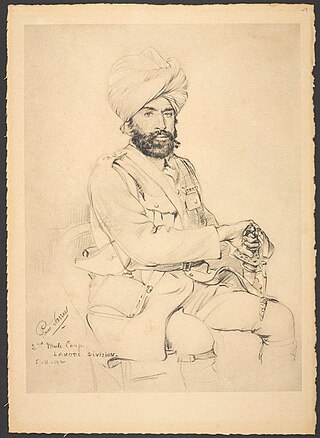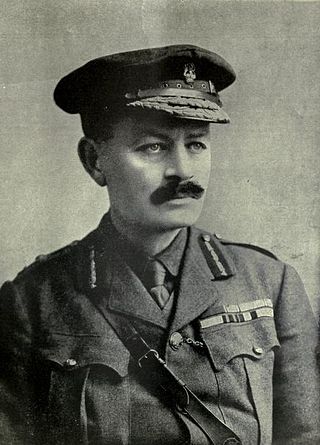Related Research Articles
The Australian Mounted Division originally formed as the Imperial Mounted Division in January 1917, was a mounted infantry, light horse and yeomanry division. The division was formed in Egypt, and along with the Anzac Mounted Division formed part of Desert Column, Egyptian Expeditionary Force in World War I. The division was originally made up of the Australian 3rd Light Horse Brigade, the reconstituted 4th Light Horse Brigade, and two British yeomanry brigades; the 5th Mounted Brigade and 6th Mounted Brigade.

The Raid on the Suez Canal, also known as Actions on the Suez Canal, took place between 26 January and 4 February 1915 when a German-led Ottoman Army force advanced from Southern Palestine to attack the British Empire-protected Suez Canal, marking the beginning of the Sinai and Palestine Campaign (1915–1918) of World War I (1914–1918).
The 10th Indian Division was an infantry division of the British Indian Army during World War I. It was formed in Egypt in December 1914 with three infantry brigades of Indian Expeditionary Force F. After taking part in the Actions on the Suez Canal, the division was dispersed as its brigades were posted away.

The Indian Army, also called the British Indian Army, was involved in World War I as part of the British Empire. More than one million Indian troops served overseas, of whom more than 60,000 died during the war.
The 4th (Quetta) Division was an infantry division of the British Indian Army. It was formed by General Kitchener while he was Commander-in-chief of India. During World War I the division remained in India. Its composition was:

The 3rd (Lahore) Division was an infantry division of the Indian Army and before 1895, the Bengal Army, first organised in 1852. It saw service during World War I as part of the Indian Corps in France before being moved to the Middle East where it fought against troops of the Ottoman Empire.
The 1st Indian Cavalry Division was a division of the British Indian Army which was formed at the outbreak of the First World War. It served on the Western Front, and was renamed the 4th Cavalry Division on 26 November 1916. In March 1918, the 4th Cavalry Division was disbanded; the British units remained in France and the Indian units were sent to Egypt to help form the 1st Mounted Division.
The 8th (Lucknow) Division was a formation of the British Indian Army's Northern Army that was first formed as a result of the Kitchener reforms of the Indian Army in 1903. The Division remained in India on internal security duties during World War I, though the 8th (Lucknow) Cavalry Brigade was transferred to the 1st Indian Cavalry Division and served in France on the Western Front, and the 22nd Lucknow Infantry Brigade served as part of the 11th Indian Division in Egypt.
The 1st (Risalpur) Cavalry Brigade was a cavalry brigade of the British Indian Army formed in 1906 as a result of the Kitchener Reforms. It remained in India during the First World War but took an active part in the Third Anglo-Afghan War in 1919.
The London Mounted Brigade was a yeomanry brigade of the British Army, formed as part of the Territorial Force in 1908.

The 15th Cavalry Brigade was a brigade-sized formation that served alongside British Empire forces in the Sinai and Palestine campaign, during World War I. Originally called the Imperial Service Cavalry Brigade it was formed from Imperial Service Troops provided by the Indian princely states of Jodhpur, Hyderabad, Mysore, and Patiala which each provided a regiment of lancers. A maximum of three regiments served in the brigade at any one time. The states of Kashmir, Idar and Kathiawar provided smaller detachments for the brigade, which was at times reinforced by other British Empire regiments and artillery batteries when on operations.

The 6th Indian Cavalry Brigade was a cavalry brigade of the British Indian Army that saw active service in the Indian Army during the First World War. It took part in the Mesopotamian campaign and was broken up soon after the end of the war.

The Force in Egypt was a British Army formation established in August 1914 to administer garrisoning armed forces in Egypt at the beginning of the First World War. The force had the objective of protecting the Suez Canal and was originally commanded by Major General Julian Byng, but he was replaced by General J. Maxwell, who took command on 8 September 1914. Initially, the main threat to the Suez came from Germany and throughout the early months several of the force's elements were sent to Europe to take part in the fighting on the Western Front. On 5 November 1914, Britain and France declared war on the Ottoman Empire, after which the Force in Egypt faced a direct threat from Ottoman forces, which was realised in February 1915 with a raid on the Suez Canal. This threat remained until 1916 when the British forces went on the offensive.
The Garhwal Brigade was an infantry brigade of the British Indian Army formed in 1902 as a result of the Kitchener Reforms. It was mobilized as 20th (Garhwal) Brigade at the outbreak of the First World War as part of the 7th (Meerut) Division and departed for France. It served on the Western Front until November 1915. It then moved to Egypt where it joined the 10th Indian Division, by now designated as 20th Indian Brigade. It left the division in March 1916 and thereafter served as an independent brigade in the Sinai and Palestine Campaign. It was broken up in 1920.
The 30th Indian Brigade was an infantry brigade of the British Indian Army that saw active service with the Indian Army during the First World War. It initially saw active service in Egypt in 1915, before transferring to Mesopotamia. It took part in a number of battles and actions before being besieged at Kut and going into Turkish captivity in April 1916.
The 32nd Brigade was an infantry brigade of the British Indian Army that saw active service with the Indian Army during the First World War. It served in Egypt in 1915 before being broken up in January 1916.

The 29th Indian Brigade was an infantry brigade of the British Indian Army that saw active service with the Indian Army during the First World War. Formed in October 1914, it raided Sheik Saiad en route to Egypt, defended the Suez Canal in early 1915, before taking part in the Gallipoli Campaign. On returning to Egypt it acted as an independent formation being broken up in June 1917.
The 28th Indian Brigade was an infantry brigade of the British Indian Army that saw active service with the Indian Army during the First World War. Formed in October 1914, it defended the Suez Canal in early 1915, ended the Ottoman threat to Aden in July 1915, took part in the Mesopotamian Campaign in 1916 and 1917, before finishing the war in the Sinai and Palestine Campaign. It remained in Palestine until it was broken up in 1920.
The 31st Indian Brigade was an infantry brigade of the British Indian Army that saw active service with the Indian Army during the First World War. It served in Egypt in 1915 before being broken up in February 1916.
The Lucknow Brigade was an infantry brigade of the British Indian Army formed in 1907 as a result of the Kitchener Reforms. It was mobilized as 22nd (Lucknow) Brigade at the outbreak of the First World War as part of Indian Expeditionary Force E. It served in Egypt in 1915 before being broken up in January 1916.
References
- ↑ Perry 1993 , p. 119
- 1 2 3 4 5 6 Perry 1993 , p. 121
- ↑ Perry 1993 , p. 122
- ↑ "Indian Army Brigades" (PDF). orbat.com. Archived from the original (PDF) on 10 October 2008. Retrieved 8 September 2009.
- ↑ Rinaldi 2008 , pp. 126–127
- ↑ Perry 1993 , p. 120